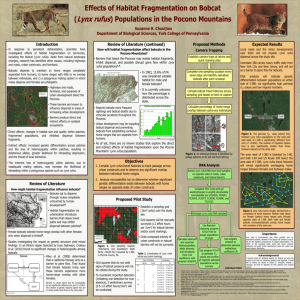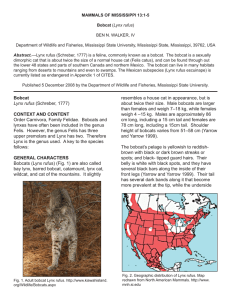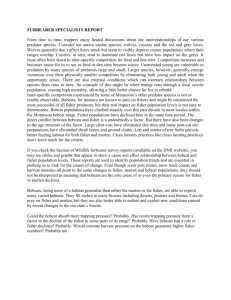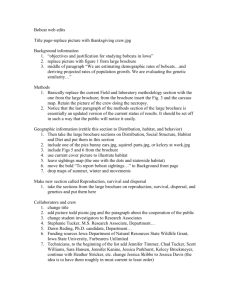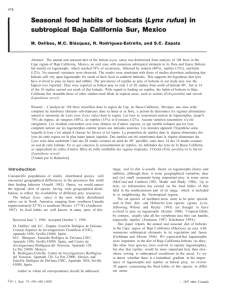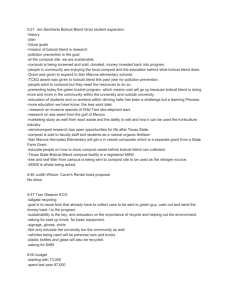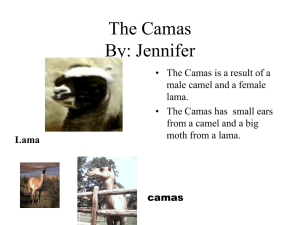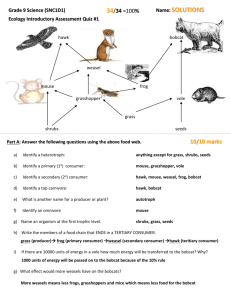Geographic Range - University of Wisconsin
advertisement
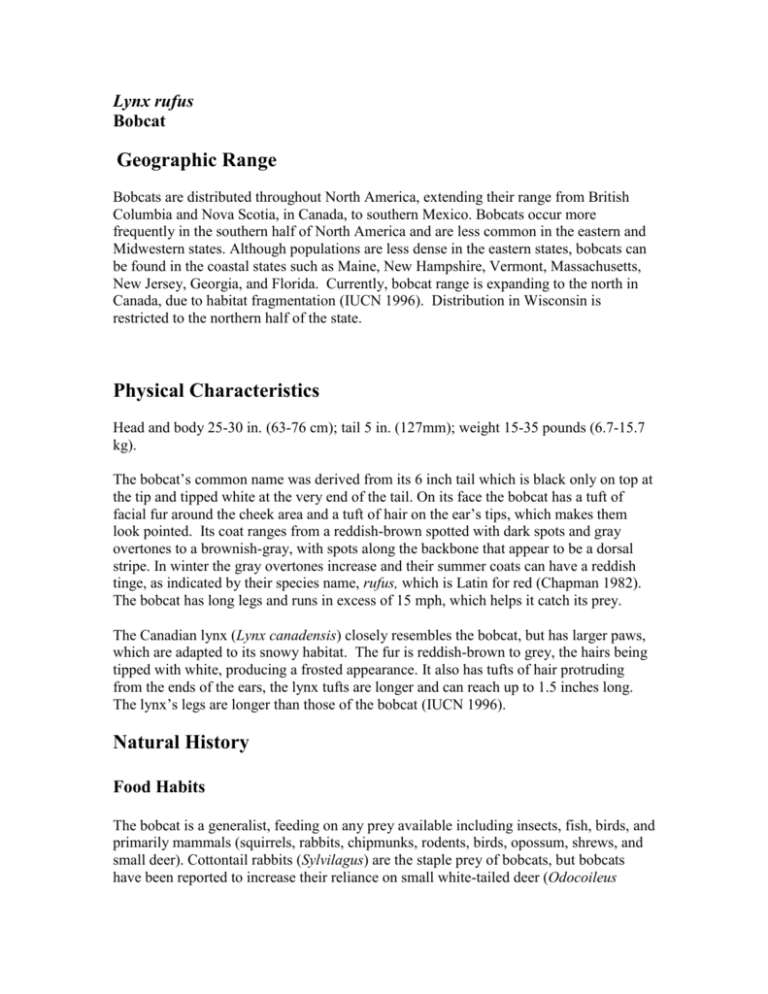
Lynx rufus Bobcat Geographic Range Bobcats are distributed throughout North America, extending their range from British Columbia and Nova Scotia, in Canada, to southern Mexico. Bobcats occur more frequently in the southern half of North America and are less common in the eastern and Midwestern states. Although populations are less dense in the eastern states, bobcats can be found in the coastal states such as Maine, New Hampshire, Vermont, Massachusetts, New Jersey, Georgia, and Florida. Currently, bobcat range is expanding to the north in Canada, due to habitat fragmentation (IUCN 1996). Distribution in Wisconsin is restricted to the northern half of the state. Physical Characteristics Head and body 25-30 in. (63-76 cm); tail 5 in. (127mm); weight 15-35 pounds (6.7-15.7 kg). The bobcat’s common name was derived from its 6 inch tail which is black only on top at the tip and tipped white at the very end of the tail. On its face the bobcat has a tuft of facial fur around the cheek area and a tuft of hair on the ear’s tips, which makes them look pointed. Its coat ranges from a reddish-brown spotted with dark spots and gray overtones to a brownish-gray, with spots along the backbone that appear to be a dorsal stripe. In winter the gray overtones increase and their summer coats can have a reddish tinge, as indicated by their species name, rufus, which is Latin for red (Chapman 1982). The bobcat has long legs and runs in excess of 15 mph, which helps it catch its prey. The Canadian lynx (Lynx canadensis) closely resembles the bobcat, but has larger paws, which are adapted to its snowy habitat. The fur is reddish-brown to grey, the hairs being tipped with white, producing a frosted appearance. It also has tufts of hair protruding from the ends of the ears, the lynx tufts are longer and can reach up to 1.5 inches long. The lynx’s legs are longer than those of the bobcat (IUCN 1996). Natural History Food Habits The bobcat is a generalist, feeding on any prey available including insects, fish, birds, and primarily mammals (squirrels, rabbits, chipmunks, rodents, birds, opossum, shrews, and small deer). Cottontail rabbits (Sylvilagus) are the staple prey of bobcats, but bobcats have been reported to increase their reliance on small white-tailed deer (Odocoileus virginianus) during the winter months in areas where they are prevalent. Their hunting strategies are based on a stalk and pounce approach (Rollings 1945). Reproduction Mating peaks in February, but the season can last from early January through June, with litters born in late April or early May. After a 63 day gestation period, 2-3 kittens are born, with only 1 litter per year produced (Bailey 1974). The young are furred and blind at birth and will nurse from their mother for the following two months. From about five months on, the mother will teach her kittens how to hunt on their own. After eight to eleven months the young are forced from their mother’s home range. Female bobcats are capable of breeding at 1 year of age, whereas males are not sexually mature until 2 years of age (Crowe 1975). Behavior The bobcat is crepuscular and is most active three hours before sunset to midnight and one hour before sunset to three hours afterwards. Daytime movements are rare except during winter months when food is scarce. Bobcats are highly territorial and solitary. Adults of each sex maintain and defend their extensive home range. Male home ranges are larger than female home ranges and size depends on quality of habitats and prey availability (Chapman 1982). For example, males may expand their boundaries during the breeding season in order to maximize the opportunities to find a mate. Females on the other hand may use less of their home range, while rearing kittens because of the need to tend to her kittens. They will mark their area with urine, feces, scent from anal glands and scrapes, which are used as markers to keep other bobcats away (Bailey 1974). Bobcats of the same sex do not share the same home range, although there is some overlap in range boundaries. Males do allow females to use their home ranges and viceversa. Mating is the only time that bobcats are together (Boyle 1987). Habitat Bobcats can adapt to a wide variety of habitats. Preferred habitats include mixed hardwood swamps, pine flatwoods, upland hardwood forests, hardwood hemlocks, old fields, and farmlands interspersed with heavily wooded forests. Common den sites include fallen trees, hollow logs, thickets, caves, and rock piles (Boyle 1987). Conservation The bobcat population is currently stable with and estimated 700,000-1,500,000 bobcats in the United States today. It is legal to hunt and trap bobcats in the United States in areas where the population is stable, but is prohibited in 11 of the states. Although hunting and trapping contribute loss in the populations, habitat destruction has a more severe effect. Therefore, maintaining and managing forest habitats are important conservation measures for bobcats. Because bobcats are highly territorial and solitary, land needs to be distributed and maintained in a way that multiple bobcats can occupy large separate home ranges (IUCN 1996). References Bailey, Theodore N. 1974. Social organization in a bobcat population. Journal of Wildlife Management. 38(3): 435-446. Boyle, Katherine A. 1987. Habitat suitability index models: bobcat. Biol. Rep. 82 (10.147). Washington, DC: U.S. Department of the Interior, Fish and Wildlife Service. 16 p. Chapman, Joseph A.; Feldhamer, George A., eds. 1982. Wild mammals of North America. Baltimore, MD: The Johns Hopkins University Press. 1147 p. Crowe, Douglas M. 1975. Aspects of ageing, growth, and reproduction of bobcats from Wyoming. Journal of Mammalogy. 56(1): 177-198. IUCN-THE World Conservation Union. 1996. “Species Survival Commission: IUCN Cat Specialist Group: Lynx rufus” (Online), Avaialable http://lynx.uio.no/catfolk/sp-accts.htm. (October 27,2003). Rollings, Clair T. 1945. Habits, foods and parasites of the bobcat in Minnesota. Journal of Wildlife Management. 9(2): 131-145. Reference written by Mindy Berendes , Biology 378 student. Edited by Christopher Yahnke. Page last updated.

